As December draws to a close, let's talk about one of the smallest predator species in Latvia – the stoat (Mustela erminea).
Currently, the stoat's fur is white, but in summer, it changes to brown with a whitish throat and belly. The tail is three times shorter than the body and has two colors – brown during summer and white in winter. The tail tip is always black. The easiest way to distinguish a stoat from a weasel is by its tail: the stoat's is longer, slender, and bi-colored, while the weasel’s tail is noticeably shorter, stubbier, and single-colored.
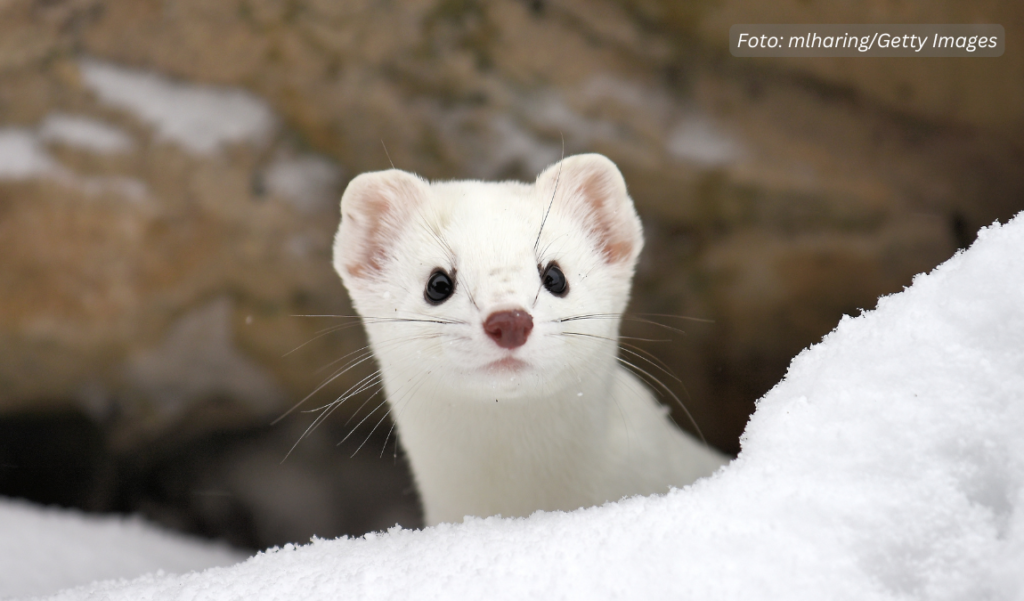
The stoat is a predator with a slender, flexible body. It measures 20–27 cm in length and weighs up to 200 g. Stoats are crepuscular and nocturnal but can be active at any time of day. They remain active year-round.
The stoat lives in forest edges, shrublands, and, most commonly, along water bodies and small low-lying marshes. In winter, it may settle near human habitation, including rural homes. It hides in piles of stones, branches, or logs, fallen tree hollows, and burrows. Females create a permanent den only during the breeding season (March–May).
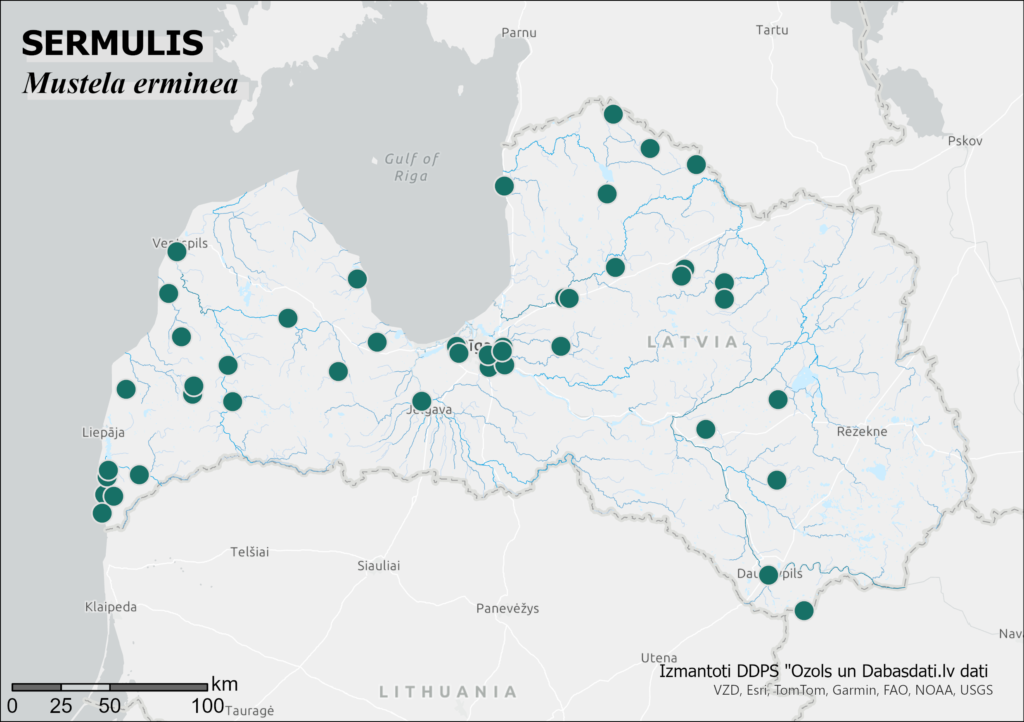
Their primary prey consists of vole-like rodents, which they primarily hunt in burrows. They also eat shrews, frogs, lizards, insects, birds and their eggs, and wild berries. Stoats are efficient hunters and, if food is abundant, will kill more prey than they can eat, storing the excess as reserves.
Stoats are polygamous and reproduce once a year. Litters can range from 3 to 18 kits, averaging 4–9. The female alone cares for the young.
The kits grow rapidly and can hunt with their mother by the eighth week. While females reach adult size at least six weeks after birth, they can mate as early as 60–70 days old, often before they are weaned. Males, however, do not reproduce or reach full size until their second summer.
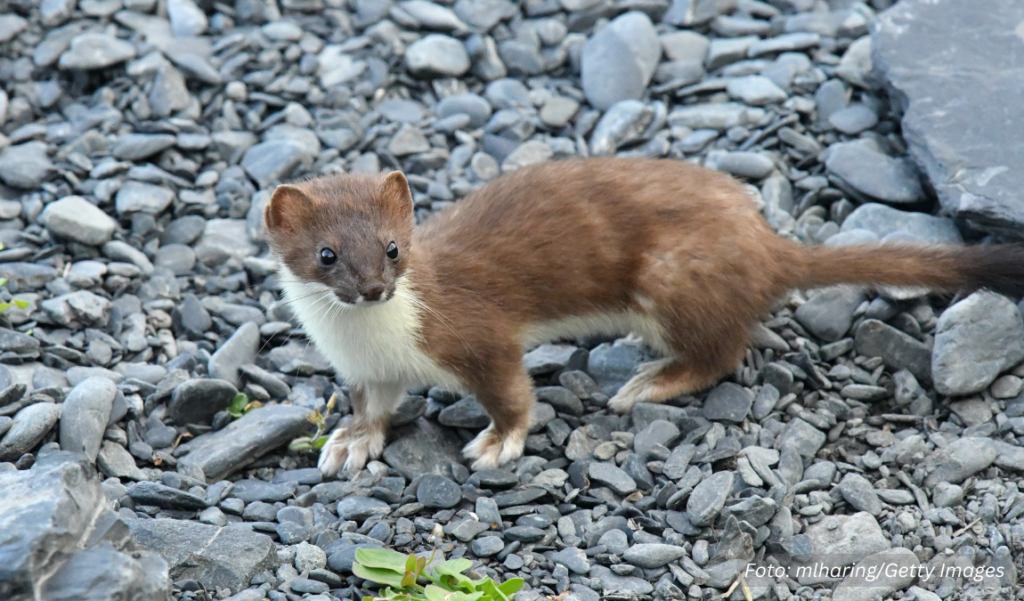
Females in the wild typically survive at least two breeding seasons, while males often do not live as long. Reproductive success largely depends on food availability.
Stoats rest and den among tree roots, hollow logs, or abandoned burrows taken over from rodents (stoats do not dig their own burrows). An individual’s territory includes multiple dens lined with dry vegetation or fur and feathers from prey. In times of plenty, stoats store food in side chambers of burrows.
In Latvia, the threats to stoats have not been well studied. However, similar to other regions, stoats may be affected by agricultural and forestry intensification, leading to habitat loss and reduced prey availability. Populations are also limited by the invasive American mink, which preys on stoats and competes for food.
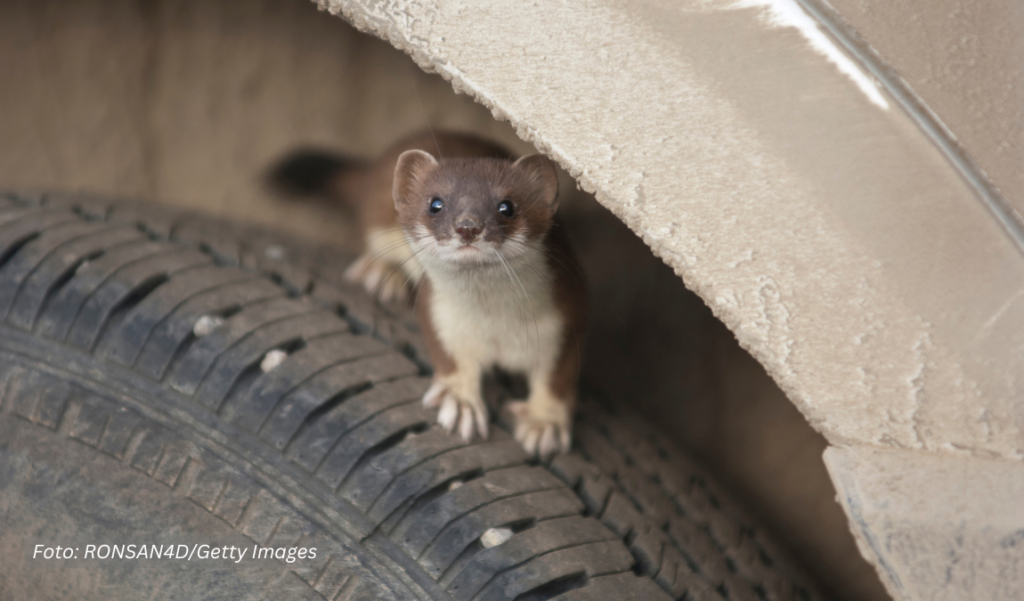
The stoat is classified in Latvia as a species with insufficient data (DD, Data Deficient) to fully assess its conservation status.
As November comes to an end, we want to highlight a very rare species – the Stiff Apple-moss (Bartramia ithyphylla). This moss has been assessed as critically endangered (CR) in our project, but we have some great news – a new population of the species was discovered in Latvia this summer!
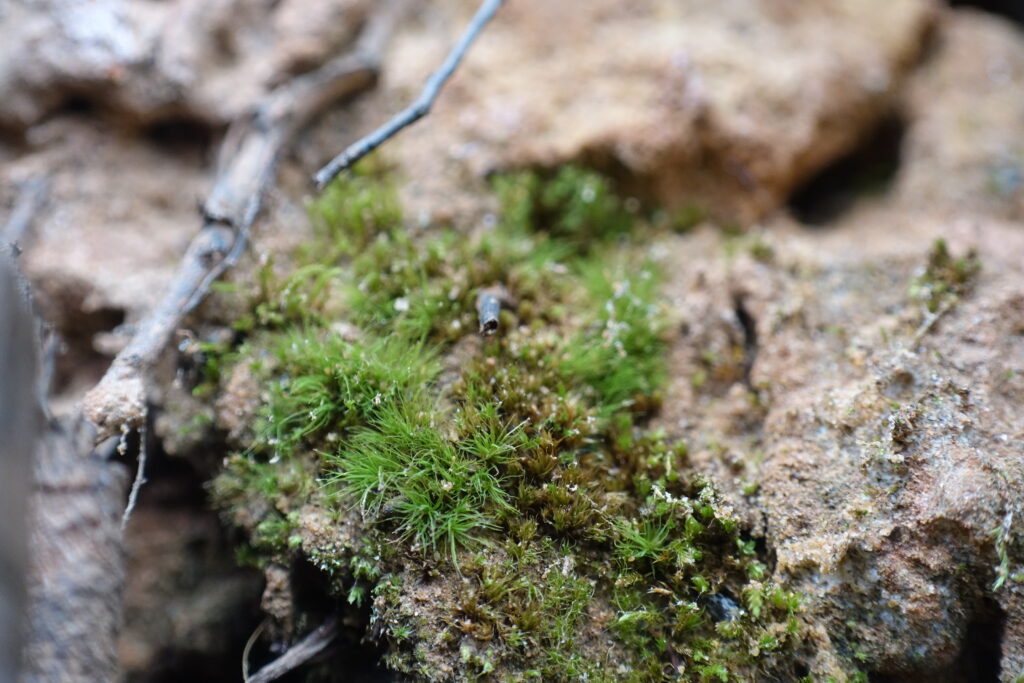
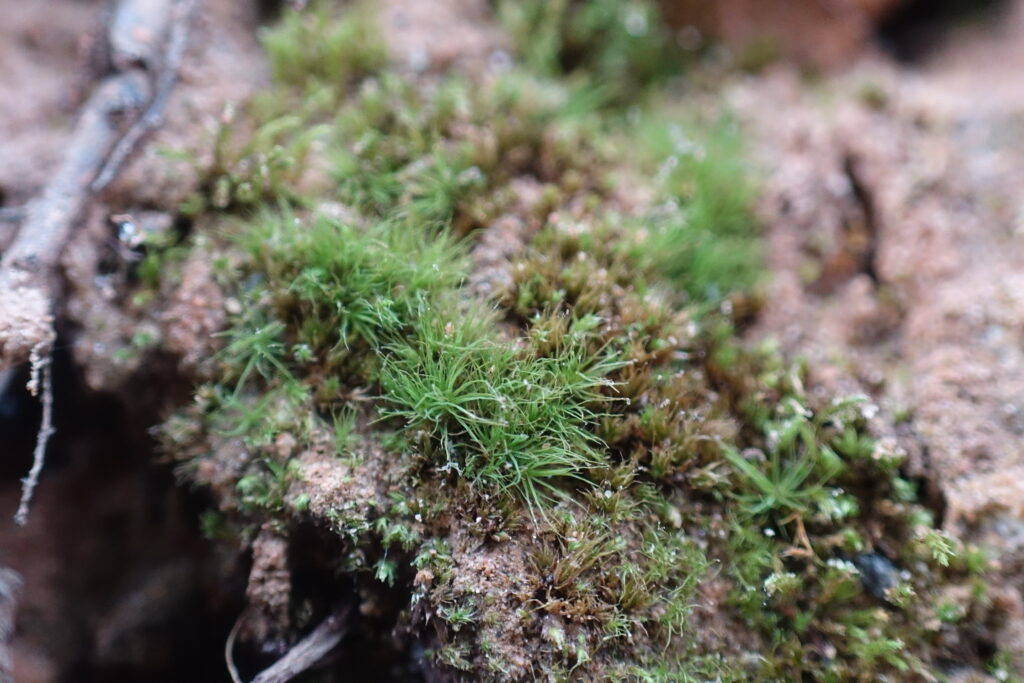
The Stiff Apple-moss is a leafy moss with colors ranging from soft green to bluish hues. When its leaves are dry, they are stiff and upright, but in moist conditions, they bend and become linear. The leaf edges are thin and toothed, with two rows of small teeth, while the leaf tip is pointed.
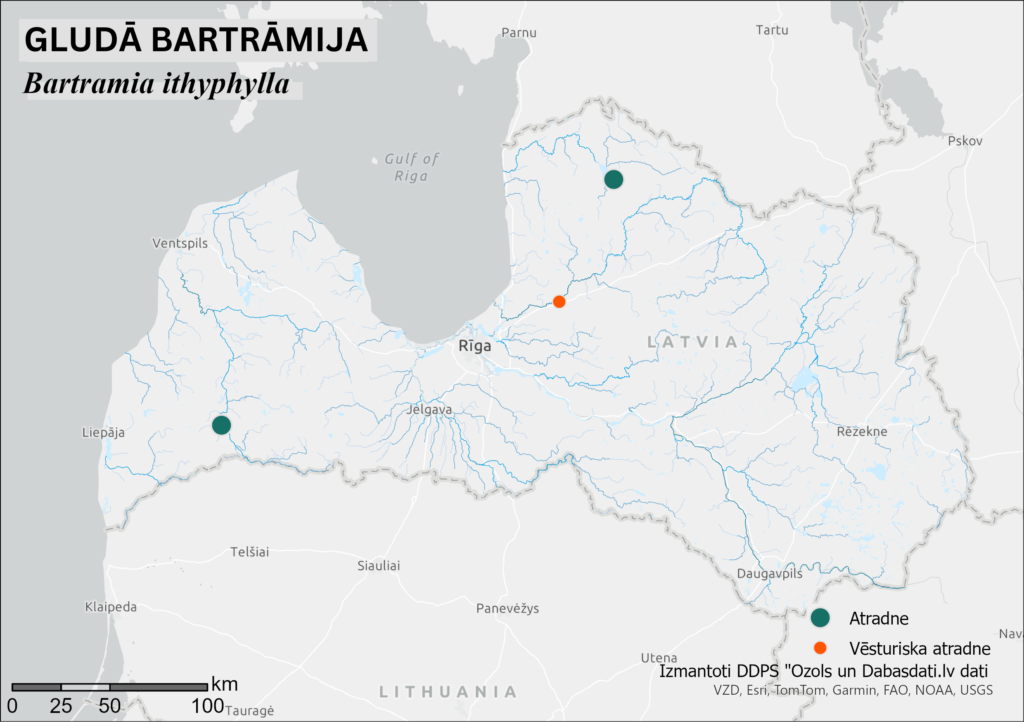
In Latvia, the species has two historical sites: one near Cēsis, along the Gauja River, and another in the Alsunga area of Kurzeme. Additionally, there are two modern sites: one in Central Kurzeme, in the Venta and Šķervelis valley near Lēnas, where it grows in an area of approximately 3x5 cm. The most recent site was discovered in 2024 by LIFE FOR SPECIES bryophyte expert Līga Strazdiņa on a sandstone outcrop along the shore of Lake Burtnieki. The species is not tied to any specific region of Latvia but depends on the availability of suitable habitats and substrates.
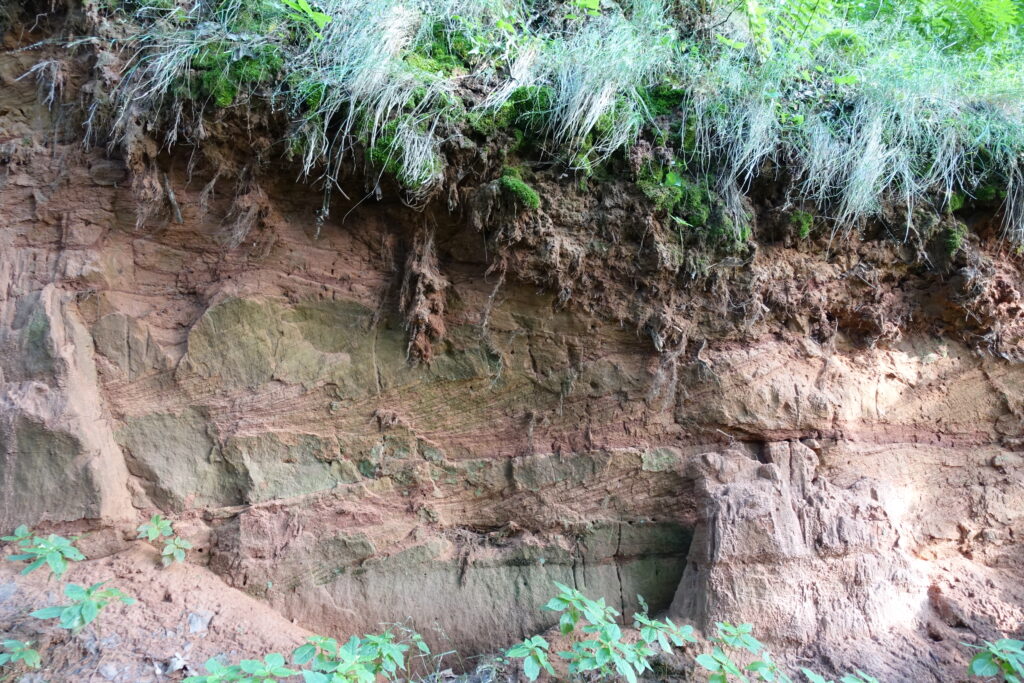
Elsewhere in Europe, Stiff Apple-moss is a widespread mountain species, found in various habitats growing on rocks and in rock crevices. In Latvia, it has been recorded on sandstone cliffs, dolomite outcrops, and clayey slopes along roadsides.
The species faces threats from increased tourism activity, damage to cliffs, and "improvements" to cliff areas, such as the removal of shrubs and trees to enhance scenic views. Such activities can lead to excessive exposure to sunlight, worsening the moss's growth conditions.
During the autumn months, we want to share more information about two bird species that have recently appeared in many social media posts by residents of Latvia – the western capercaillie (Tetrao urogallus) and the black grouse (Lyrurus tetrix). While these birds might seem similar at first glance, they differ in both appearance and behavior.
In this article, we will explain how to distinguish between these two species and provide more details about their characteristics and conservation.

One of the main differences between the two species is their size, especially among the males. The black grouse is roughly the size of a chicken, while the western capercaillie is closer in size to a turkey. Distinguishing between the females of these species can be more difficult, as the size difference is smaller, and both females have a brown mottled coloration. However, one "cheat code" is the rusty-orange coloration on the breast of the capercaillie female.
Western capercaillies feed on pine needles during winter, whereas black grouse are often seen eating birch buds in winter, where they are easily visible on bare birch trees from a distance. Both species may spend nights in the winter sleeping under snow (if it's deep enough), as it provides insulation and warmth.

The male is bluish-black with a greenish sheen on the chest. Its wings are black-brown with a white shoulder patch, and the tail, belly, and sides have white spots. The female is smaller, with a reddish-brown mottled appearance and a brown crescent-shaped patch on the chest.
For most of the year, the western capercaillie feeds on pine needles, while in spring, the flowers of cotton grasses become important, and in summer, it feeds on various buds and flowers, especially blueberry.
In spring, the species is known for its elaborate courtship ritual, where males gather at specific sites (called leks) to sing and mate with females. The males are polygamous
The nest is built on the ground near tree roots or in similar locations, with a clutch of 5–11 eggs. There is one brood per year, and the young are precocial. The female raises the young on her own. The western capercaillie is a resident species.
Most of the western capercaillie lekking areas are dominated by pine forests. These leks are typically located in more natural forests with plenty of fallen trees, dry areas, and old trees. The capercaillie mainly leks in forests over 60 years old.

The species is threatened by various forms of forestry activities: habitat fragmentation, replacement of old forests with new stands, replacement of pine with spruce, and more. The species is also threatened by road infrastructure.
The project has assessed the species as endangered (EN), meaning it faces a very high risk of extinction in the wild.

The black grouse is a chicken-sized bird. The male has black plumage with a violet sheen and a white under-tail. Its tail is lyre-shaped, and it has red eyebrows. The female is smaller and reddish-brown. Both sexes have a white stripe on the wing in flight, but the female's stripe is narrower.
The black grouse is a social bird, especially the males, which stay in groups year-round.
Adult birds feed on plant-based food, including undergrowth plants (such as lingonberries, blueberries, and heather) as well as buds, shoots, and flowers of trees like birch and alder.
The young chicks feed mainly on insects during the first weeks of life and gradually transition to plant-based food.
In spring, males gather at leks, where they sing, fight, and mate with females. The males are polygamous. The nest is built, eggs are incubated, and the young are raised by the female alone.
The nest is on the ground, typically near a tree trunk or under the cover of shrub branches, with 6–12 eggs per clutch. There is one brood per year, and the chicks are precocial. The black grouse is a resident species.
The black grouse inhabits forest edges, primarily in transitional habitats between forests and open landscapes – forest edges, young regenerating stands after fires, windthrow areas, and clear-cuts, as well as agricultural land adjacent to forests, shrublands, and moss and grass bogs. The presence of trees is important for the black grouse, but they should not be in dense stands.

In Latvia, the black grouse can be hunted from September 1 to December 31, though hunting is minimal.
The species is threatened by forestry activities that fragment habitats, increase predation risk, and cause disturbance. Habitat degradation also occurs due to the drainage of bogs. Significant threats also include predation and disturbance from recreational activities.
The project has assessed the species as vulnerable (VU).
Last week saw the successful conclusion of the LIFE FOR SPECIES international conference "Safeguarding Biodiversity: Red Lists and Beyond." The conference took place from September 18-20 in Riga, with participants also having the option to join remotely (hybrid format). The event attracted over 140 participants representing 14 countries, including the Philippines, Nepal, and the USA.
On the first day of the conference, participants had the opportunity to join one of four excursion groups organized in collaboration with the participants of the "Nordic Baltic LIFE Platform meeting".

The variety of routes provided participants with a chance to explore protected species in Sigulda, river restoration mechanisms in northern Latvia, conservation efforts in the Krustkalni Nature Reserve, and nature conservation examples in the western Latvian region. Each route offered an in-depth look at the achievements of Latvian LIFE projects, sharing valuable experience in species and nature conservation.

On the second day of the conference, September 19, there was a formal opening ceremony, followed by 11 diverse and educational oral presentations on species conservation cooperation, species monitoring, and other related topics. Participants also had the opportunity to view and discuss 27 poster presentations.
For more information about the conference, please visit the conference website. A detailed program can be found here.
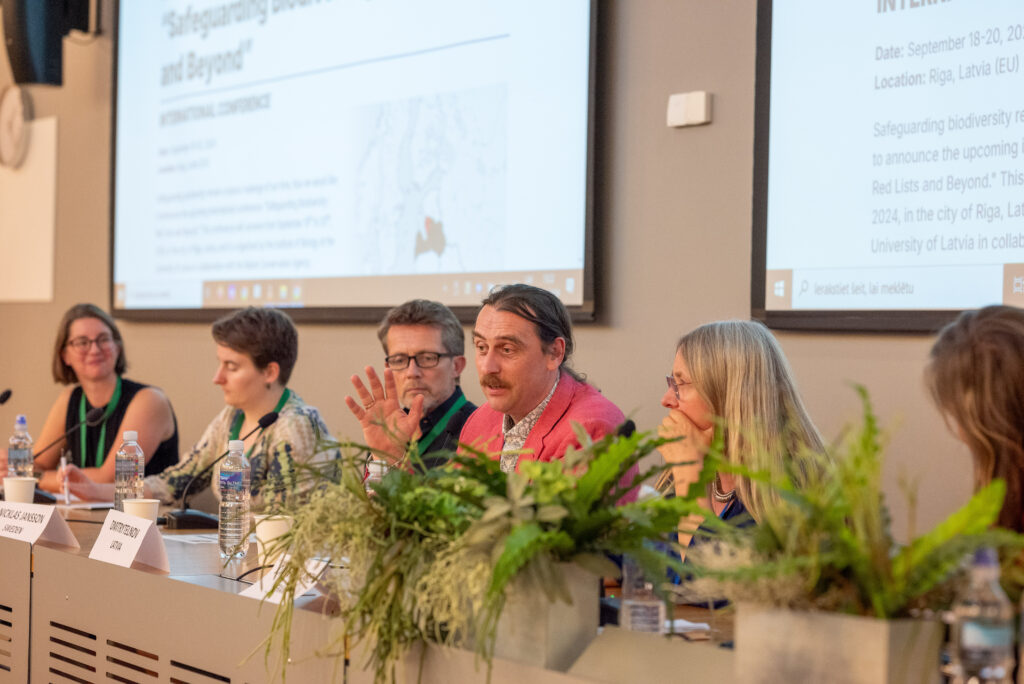
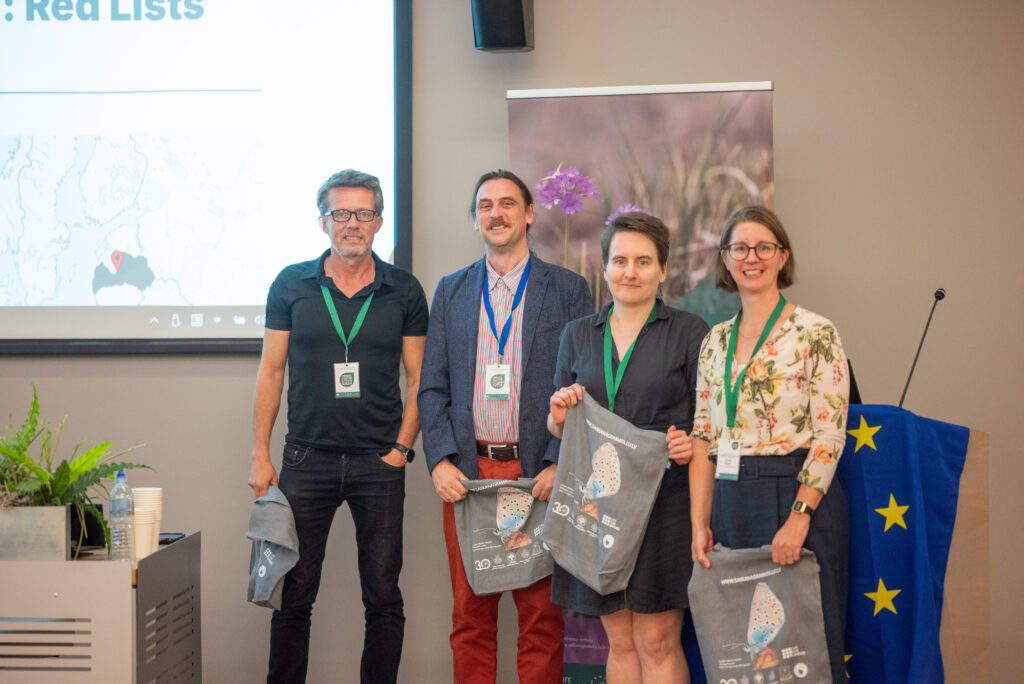


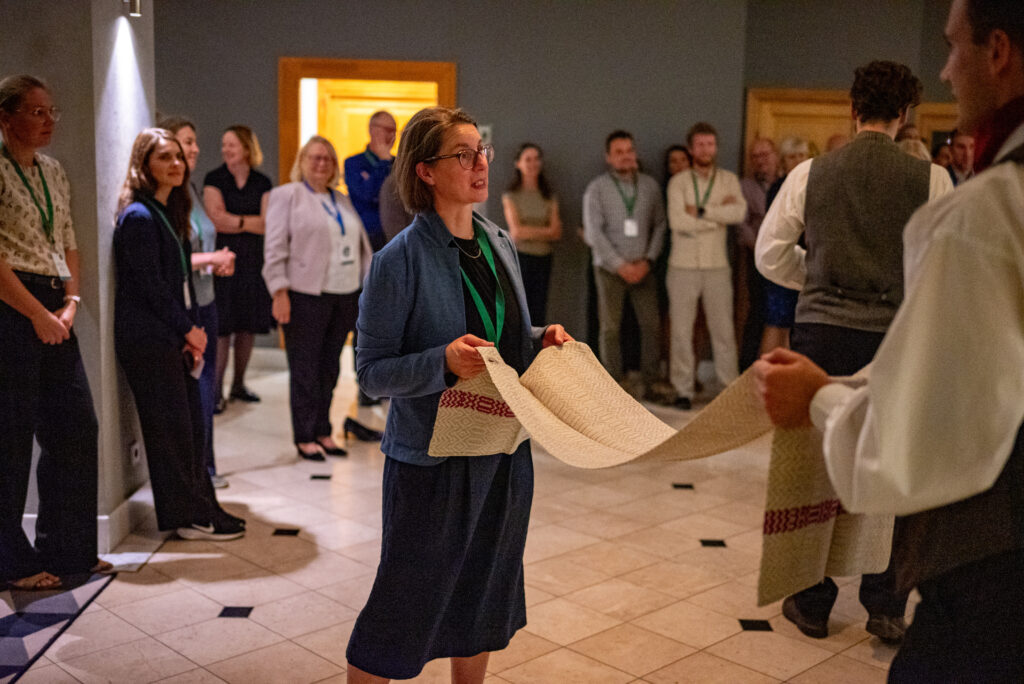

On the final day of the conference, September 20, 13 presentations were delivered on topics such as nature communication, various species protection mechanisms, and many others. Additionally, a database session titled "Biodiversity Data Systems: Storage, Analysis, and Sharing" was held, featuring 9 reports led by Jēkabs Dzenis, coordinator of the Nature Conservation Agency's project.

During the two presentation days, participants had the opportunity to vote for their favorites from oral presenters, poster presentations, and the database session. At the conclusion of the event, the project manager awarded diplomas and small mementos to the winners.
Among the oral presenters, the audience's favorite and first-place winner was keynote speaker Nicklas Jansson from Sweden, who gave an in-depth presentation on innovative solutions for creating habitats for protected invertebrate species. The second place went to Narayan Prasad Koju from Nepal, who joined remotely and shared insights into snow leopard research, community involvement in studies, and the harmony between people and nature in the mountains of Nepal.
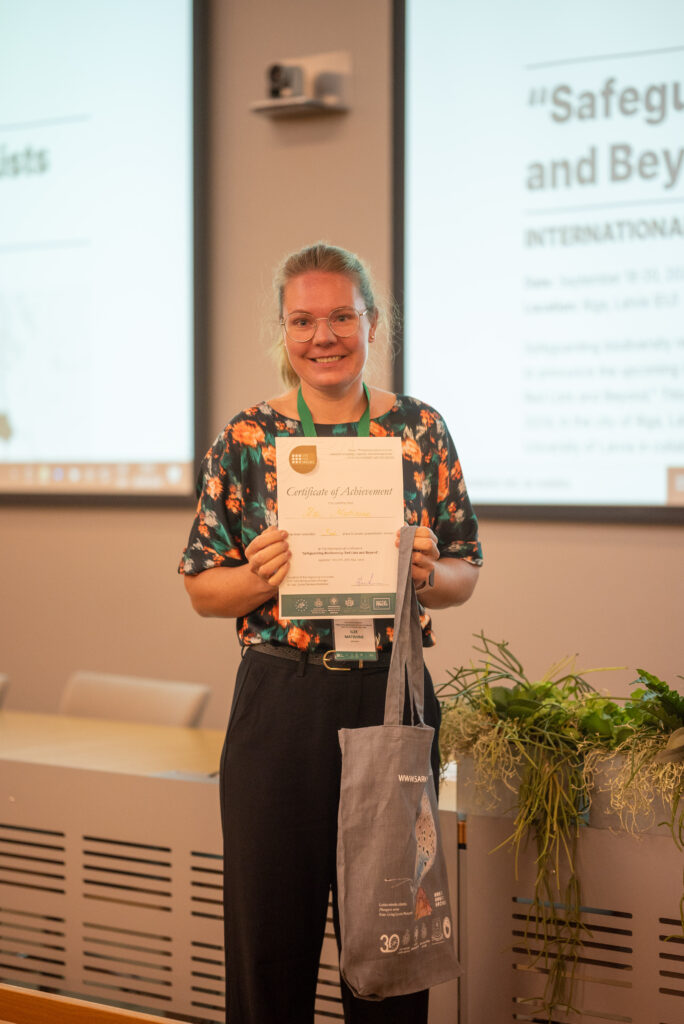
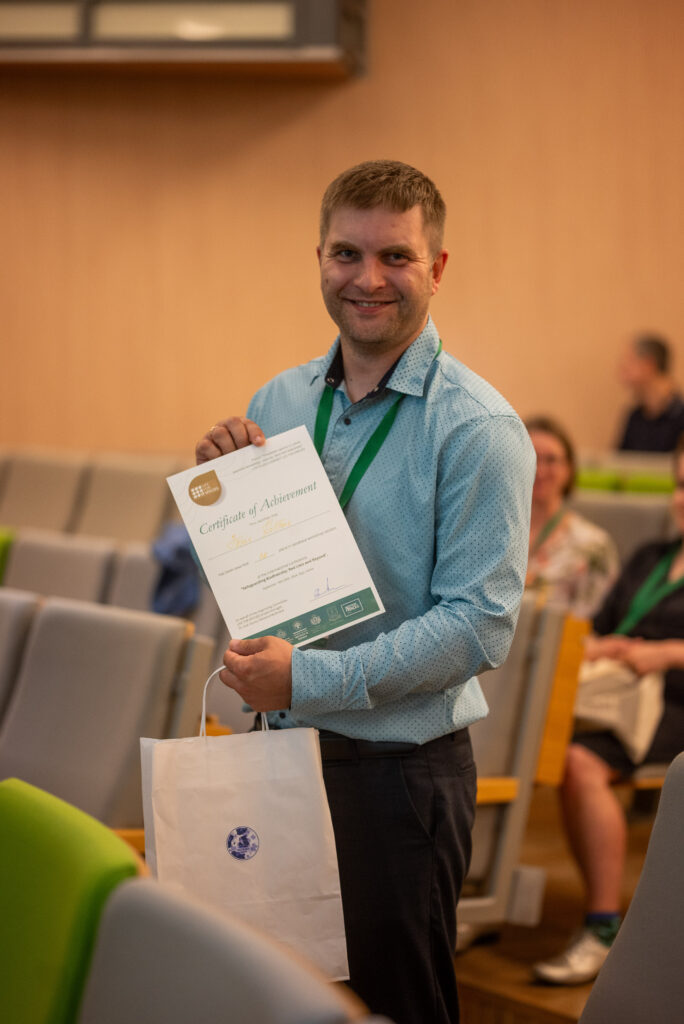
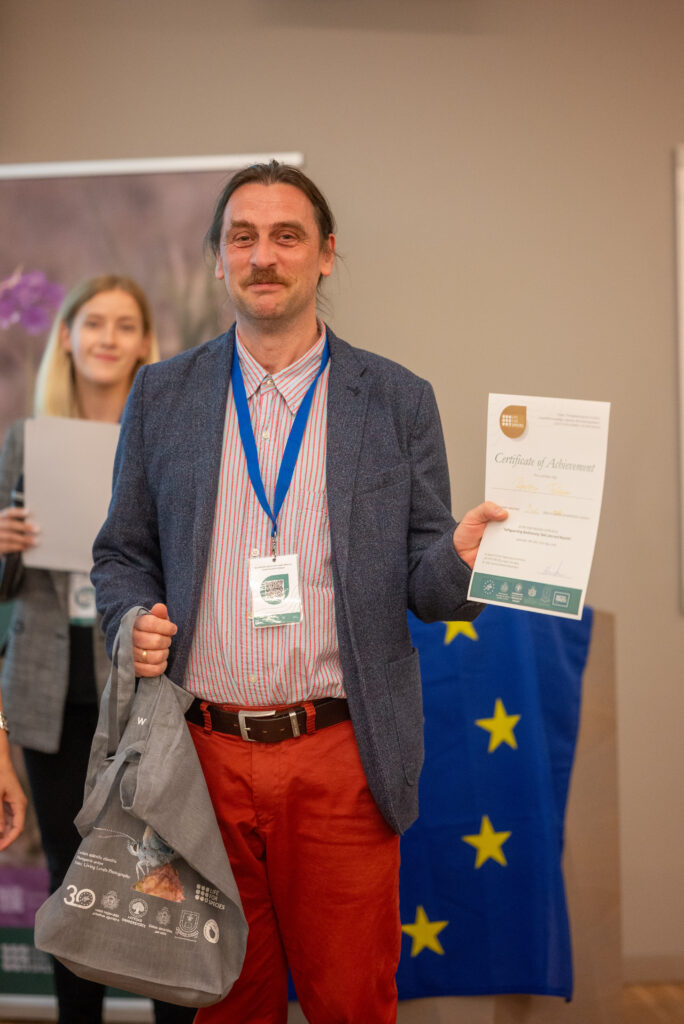
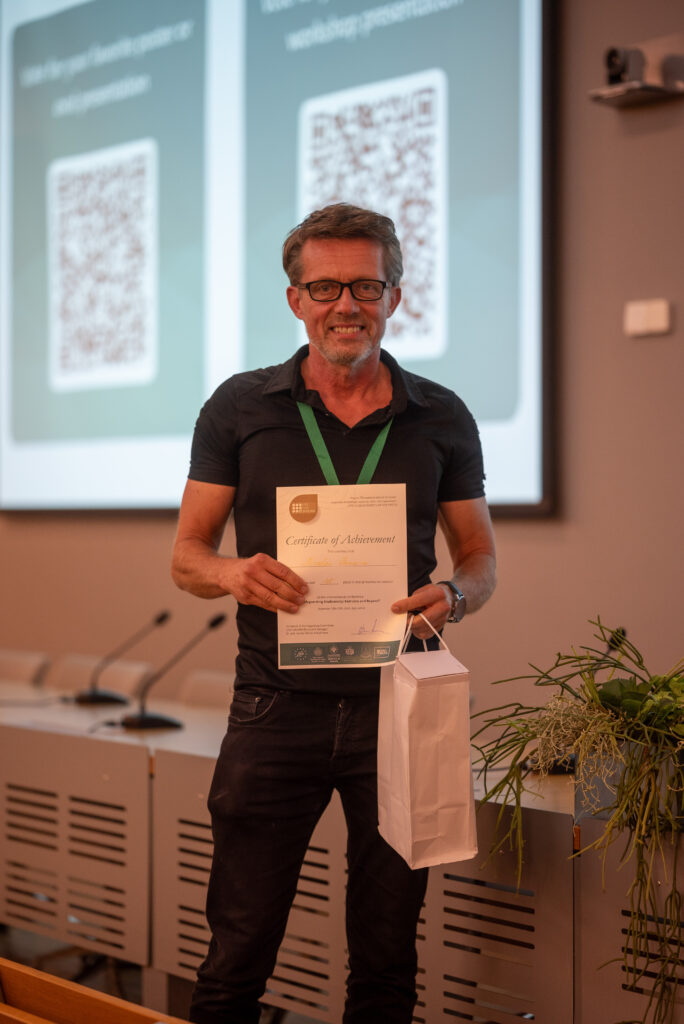
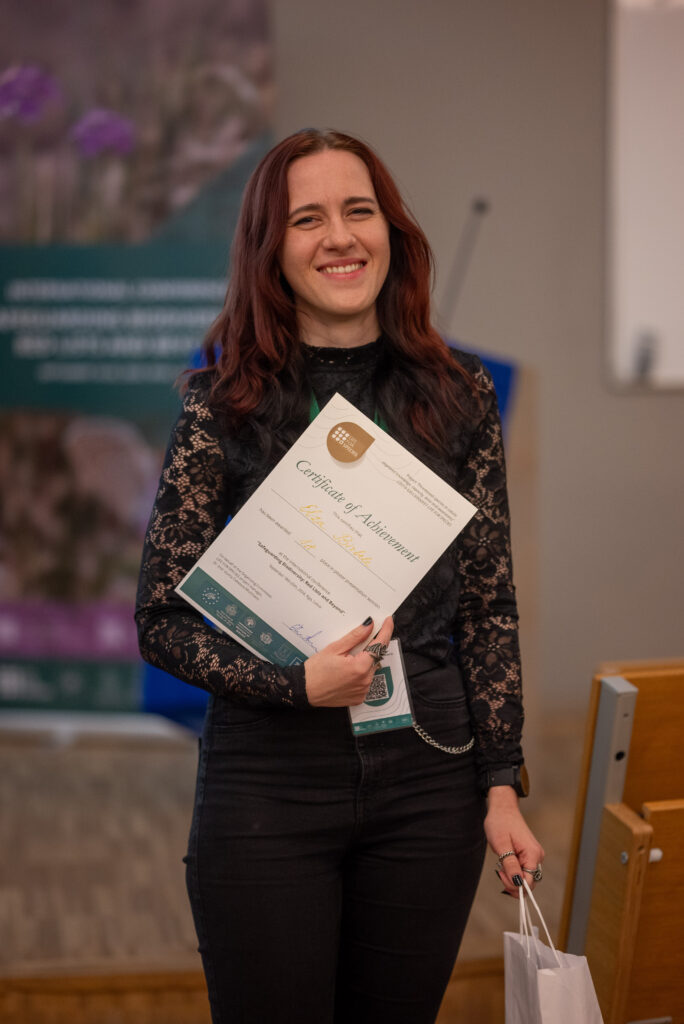
Third place was awarded to Dmitrijs Teļnovs, leader of the invertebrate species group of the LIFE FOR SPECIES project from the University of Latvia and keynote speaker, whose presentation highlighted the project's achievements in protecting rare and endangered species in Latvia.
In the poster session, Elza Birbele won first place for her poster on the identification of natterjack toads after their release into the wild. Second place went to Rūta Starka for her poster on the IUCN assessments of grasshopper species in Latvia. Ilze Matisone took third place with her presentation on the condition of young ash stands in Latvia after their dieback.
In the database session, participants voted for the best presentation, with Jānis Kotāns winning for his presentation on the national database "OZOLS."
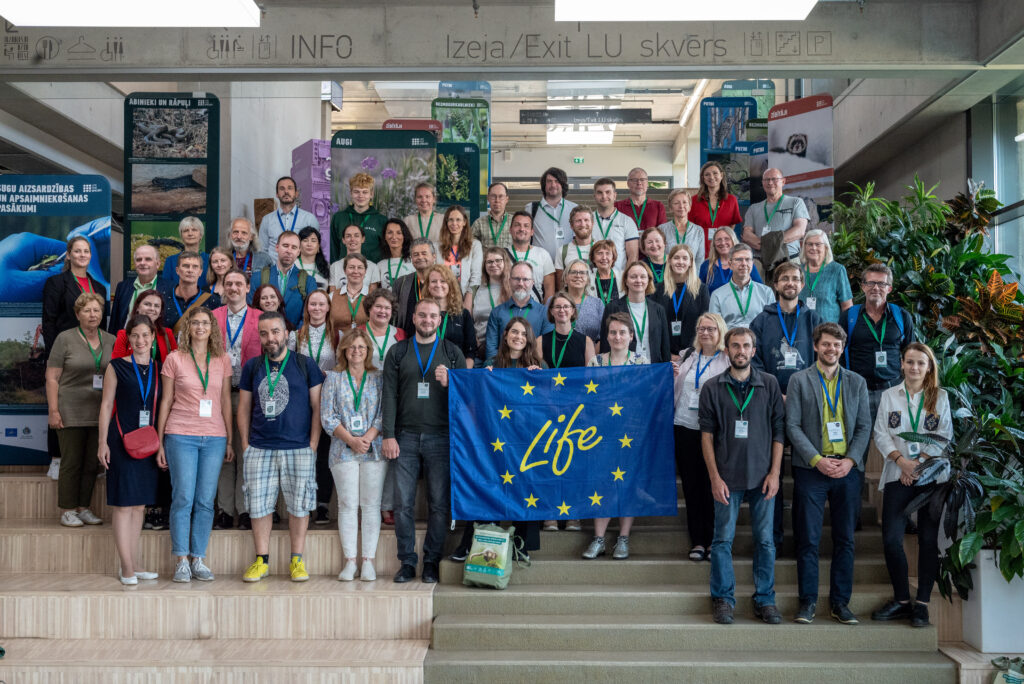
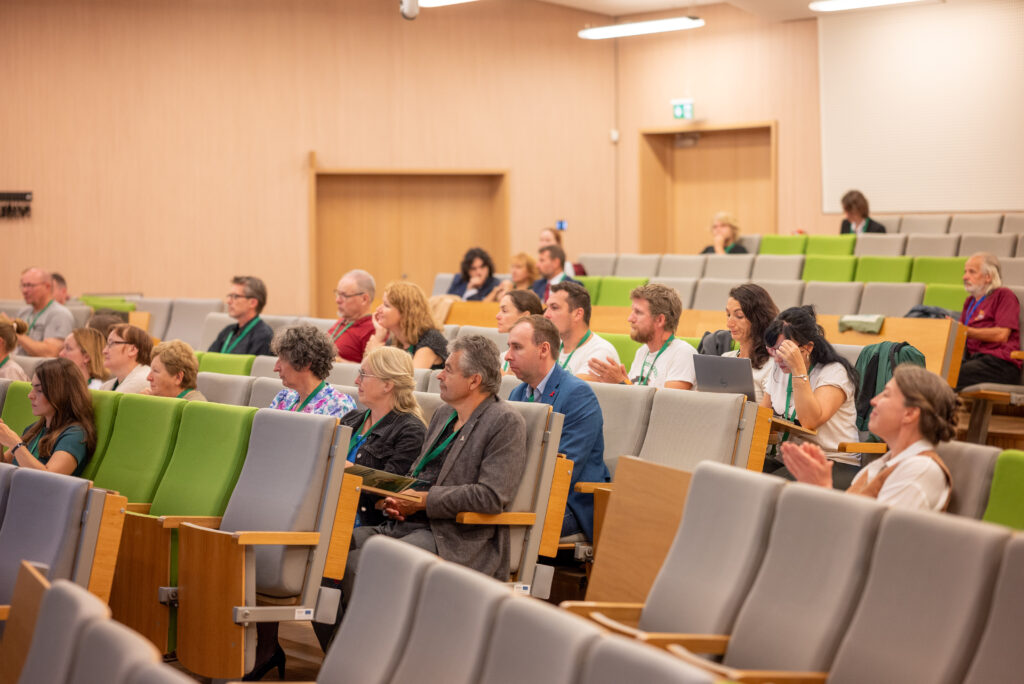
In total, the conference featured 33 oral presentations, including 6 keynote speaker presentations and 27 poster presentations. The diversity of presentation topics can be explored in the conference's Book of Abstracts.
LIFE FOR SPECIES project participants delivered 17 presentations at the conference:
A huge thank you to all the participants and the organizing team for their hard work in making the conference a success!

Special thanks to the volunteers: University of Latvia students Jeļena Mjagkova and Barbara Auzāne.
The conference was organized by the LIFE FOR SPECIES project – the University of Latvia's Institute of Biology in collaboration with the Nature Conservation Agency, Daugavpils University, and the French Institute in Latvia.
A scientific article on the Red List of Latvian lichens, that was developed using IUCN criteria, has just been published - "Toward the first Red List of Latvian lichens according to the IUCN criteria."
The lead author of the article is Polina Degtjarenko, an expert from the LIFE FOR SPECIES project at Daugavpils University. Co-authors include Latvian lichenologists Renāte Kaupuža and Rolands Moisejevs from Daugavpils University, as well as lichenologists Jurga Motiejūnaitė from Lithuania and Tiina Randlane from Estonia.
The article has been published in the internationally cited journal "Plant Biosystems - An International Journal Dealing with all Aspects of Plant Biology" and is available here: https://www.tandfonline.com/doi/full/10.1080/11263504.2024.2399056
The article is also available in PDF format here: https://ej.uz/lichens
The article is dedicated to the memory of the outstanding Latvian lichenologist Dr. Alfons Piterāns. A short tribute is included on the first page of the article.
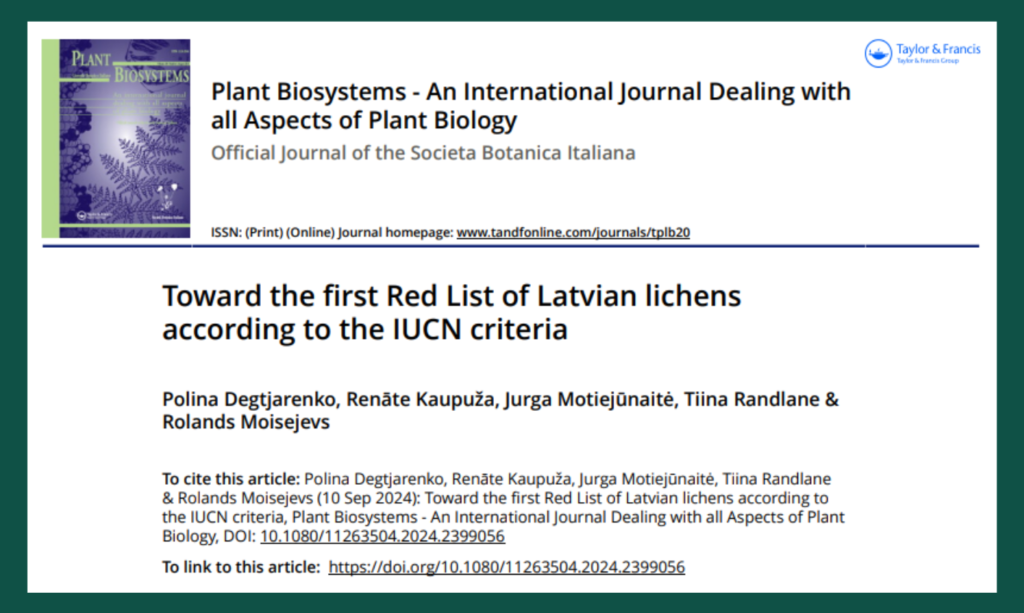
Liene Auniņa, the coordinating species expert for vascular plant species from the project LIFE FOR SPECIES, from the Institute of Biology (University of Latvia), participated in the XX International Botanical Congress (IBC) in Madrid, Spain, 21-27 July 2024.
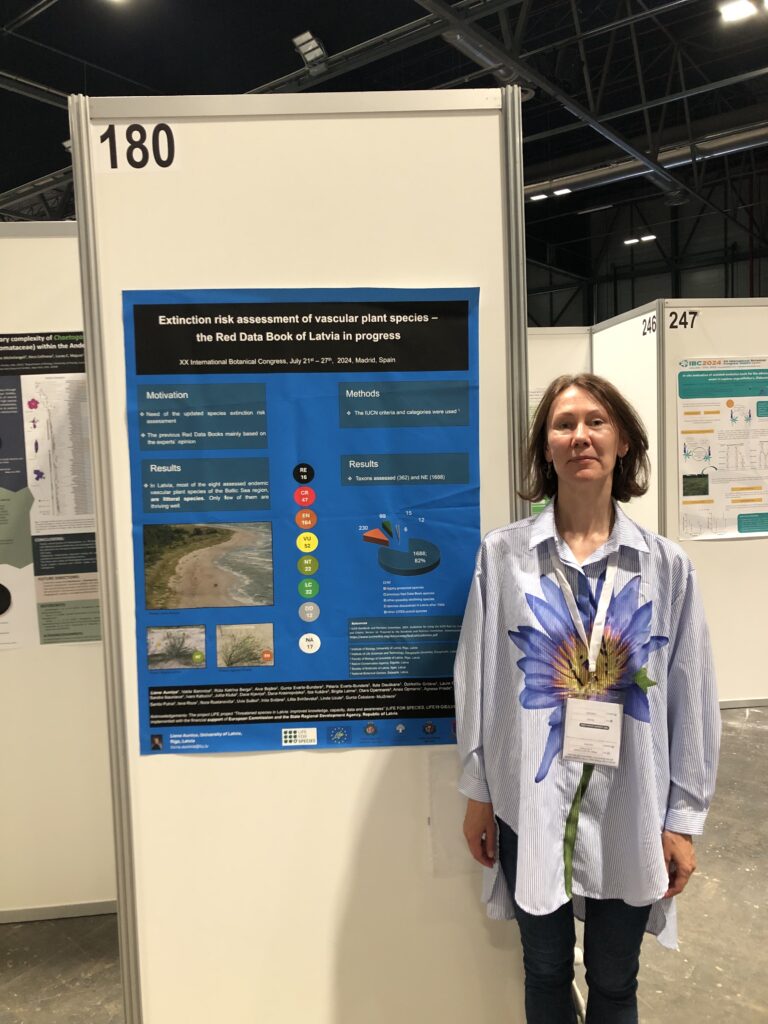
The IBC is one of the most significant meetings for botanists, which takes place every six years under the supervision of the International Association for Botanical and Mycological Societies (IABMS). The Congress included the opening lecture, 6 plenary lectures, 18 keynote lectures, 4 public lectures, concurrent 267 symposia, as well as short courses and workshops. There were 1608 talks and c. 1400 posters in the congress. The number of registered botanists was 2998 from all continents. There were 40 symposium topics, covering Systematics, Conservation Biology, Global Change Biology, Biogeography/Phytogeography, Ecology and Plant Communities etc. Symposia devoted to the synergy of art and botany, the use of plants in traditional medicine, as well as to lifelong botanical education and citizen science also took place in the congress. There were many exhibitors presenting different publishers, Botanical Societies as well as the LIFE project `LIFE4POLLINATORS (LIFE18 GIE/IT/000755) - Involving people to protect wild bees and other pollinators in the Mediterranean` in the congress venue. On the last day of the congress, the Madrid Declaration was approved proposing ten strategic actions for plant scientists, botanical institutions, governments, the corporate sector, and civil society, aiming to address plant life degradation caused by human activities (https://globalplantcouncil.org/the-madrid-declaration/).
Liene Auniņa presented the poster Extinction risk assessment of vascular plant species in Latvia: first results, co-authored by other assessors for vascular plant species in Latvia, under the symposia S.153 Systematics, floristics, and conservation, facilitating data integration to promote sound science. The aim of the presentation was: to introduce the international public (botanists from all over the world) with the results of the evaluation of Latvian plant species according to the IUCN criteria to, and to exchange experience in the research and conservation of rare and threatened species.
Liene Aunina participated in various symposia e.g. Systematics, floristics, and Conservation, facilitating data integration to promote sound science, Inventorying the plant diversity of the Euro-Mediterranean, Integrating taxonomical progress into dynamic web check-lists and electronic floras, Orchid phylogenomics: diversification, trait evolution, and biogeography, The key role of refugia in facing the global biodiversity crisis, as well as in the workshop `World Flora Online: how to get involved`.
Link to the congress website: https://ibcmadrid2024.com/
Conclusions and feedback:
At the end of August, more and more mushroom hunters can be found in the wast Latvian forests, so we encourage everyone out searching for autumn treasures to be observant. You might come across this month's protected species – Trichaster melanocephalus.
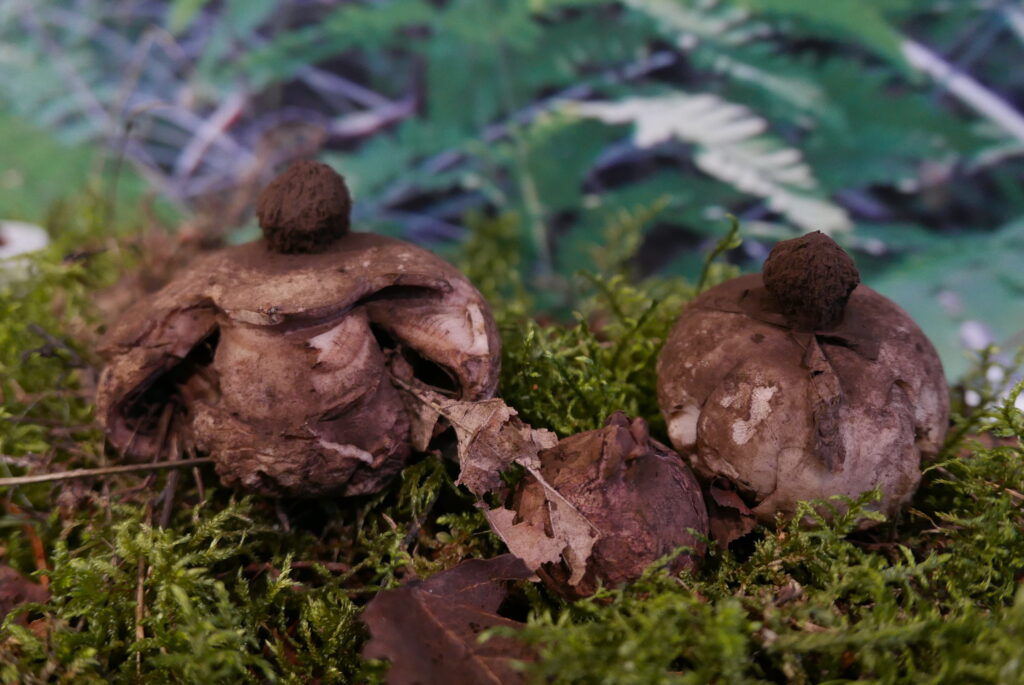
Trichaster melanocephalus (syn. Geastrum melanocephalum), like other earthstars, resembles a puffball surrounded by a membrane that splits into lobes, giving the fungus its star-like appearance.
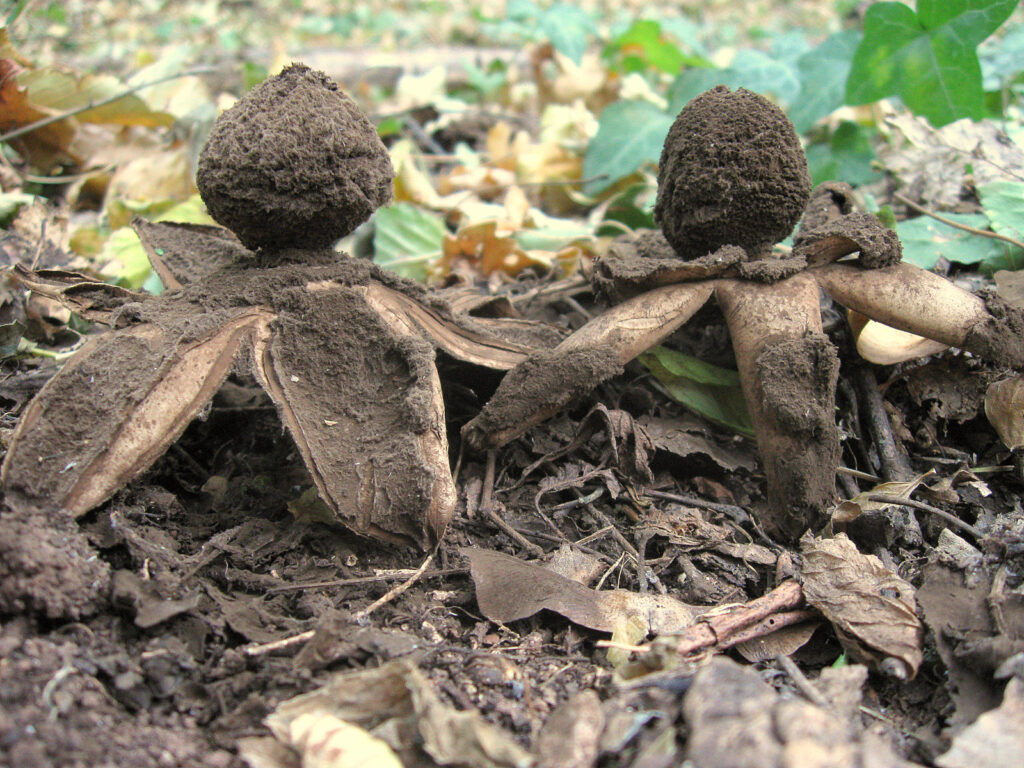
This is the largest earthstar species found in Latvia, with a diameter that can reach up to 7-15 cm. After the inner and outer membranes split, the fungus develops 4-6 lobes, and occasionally even 8. It is most commonly found in deciduous and mixed forests with rich soil.
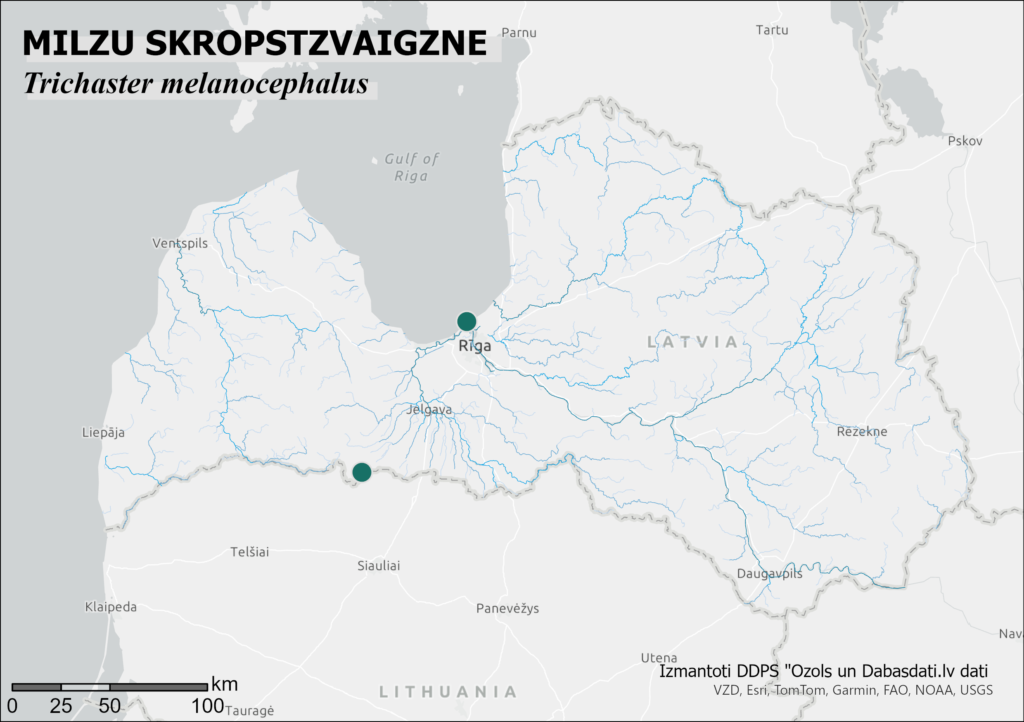
Trichaster melanocephalus is threatened by ecosystem changes and degradation caused by logging and wood extraction.
Research conducted during the LIFE FOR SPECIES project has classified the species as critically endangered, meaning there is a very high risk of extinction in the wild.
In July, we would like to highlight a truly colorful species – the fire-bellied toad (Bombina bombina). In Latvia, this species is primarily threatened by the overgrowth of ponds, which reduces the number of suitable breeding sites and habitats.


The fire-bellied toad is small in size, typically reaching only 5-6 cm in length. Its back can vary in shades of brown or olive-gray, often adorned with darker spots. The belly is bluish-black with bright red or orange patches, which is where the species gets its common Latvian name. The pupils of its eyes are heart-shaped. If you encounter this rare species in the wild, be cautious, as its skin secretes a toxic substance.
Fire-bellied toads begin breeding at two years of age, with the majority of the breeding population consisting of individuals 4-5 years old. The maximum lifespan of the species in the wild is just 6 years for males and 7 years for females, although in captivity, the recorded maximum lifespan is around 20 years.
Research conducted during the LIFE FOR SPECIES project has classified the species as vulnerable in Latvia (VU).
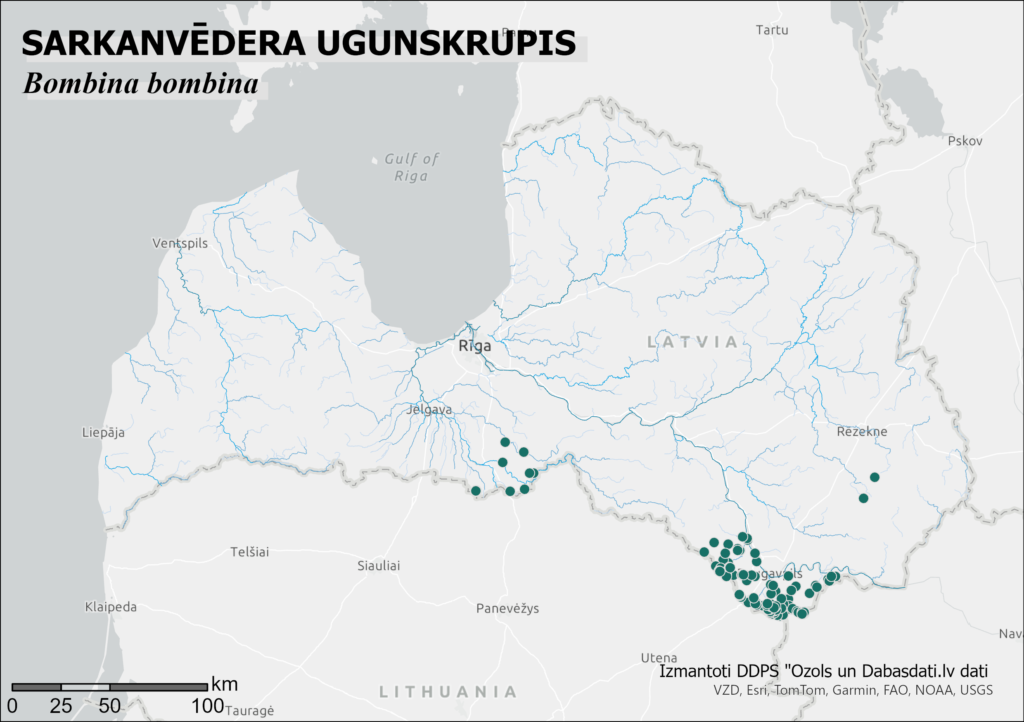
The breeding season for fire-bellied toads is extended and lasts from May to June, although male vocalizations can be heard until autumn. The entire active period is spent in bodies of water, mainly ponds, and gravel or peat quarries. For spawning, they choose water bodies with stable water levels, avoiding ponds with sandy shores and preferring those with clayey soils.
During the breeding season, the male fire-bellied toad can be distinguished from the female by the dark brown nuptial pads on the inner forelimbs. The total number of eggs is small (~300), laid in clusters on underwater vegetation. The tadpoles hatch after 4-10 days and are characterized by a high tail fin with a reticulated structure. Fire-bellied toad tadpoles tend to stay in overgrown areas of the water layer, with metamorphosis occurring in the second half of August. The length of young toads after metamorphosis is around 1-1.5 cm. They feed on small aquatic creatures (mosquito larvae, etc.) and invertebrates from the shore (spiders, flies, insect larvae). The species most often hibernates on land.
This weekend, many of us will be heading out in search of wildflowers for Midsummer celebrations. Before you go, we encourage you to learn about this month's protected species - the Siberian Iris (Iris sibirica L.), so it doesn't accidentally end up in a Midsummer wreath or festival decorations.
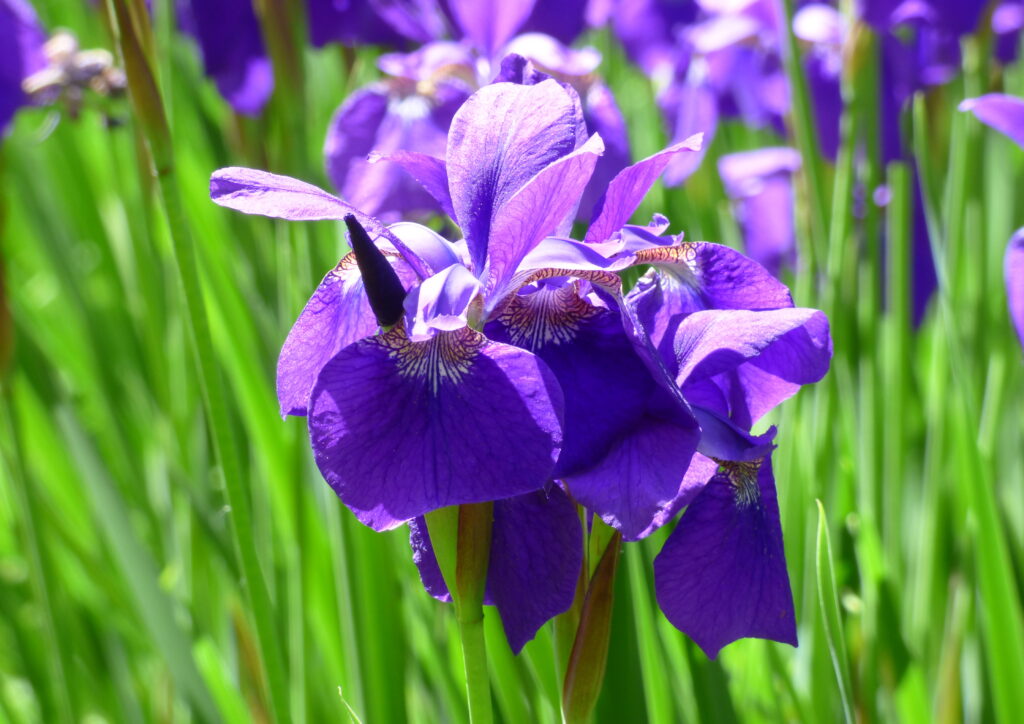
The plant usually stands 70-100 cm tall, with linear leaves up to 40 cm long, sword-shaped, shorter than the stem, arranged in two rows in a rosette, and slightly grooved at the base. The flowers are large and striking, usually 2-3 in a fan-shaped inflorescence.
The outer tepals are bent downwards, dark blue with lighter blue stripes inside. The inner tepals are erect, closed, and dark blue. The style is short, with three petal-like lobes. The Siberian Iris blooms in May and June, so you might come across it while exploring nature at this time!
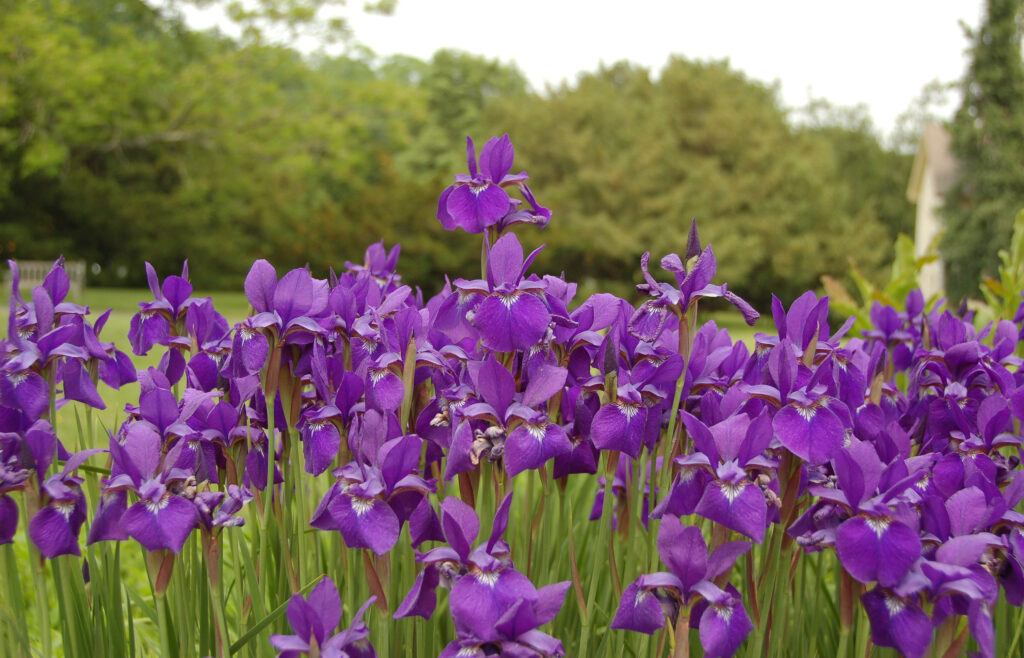
The species is widespread in Central and Eastern Europe, mainly in temperate and moderately warm zones. In Latvia, the species is relatively rare and unevenly distributed, primarily found in the Coastal Lowland of Western Latvia, Eastern Latvia, and the Daugava River valley and its tributaries in Central Latvia. In Latvia, the species grows near the northern edge of its range.
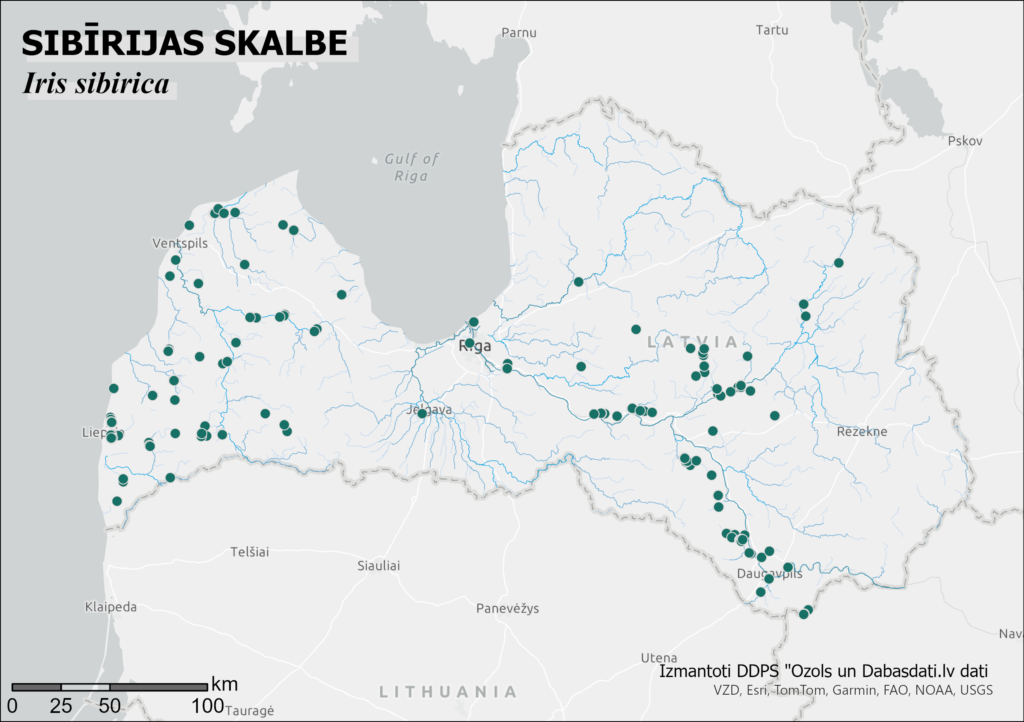
The Siberian Iris is found in wet and marshy floodplain meadows and outside floodplains, as well as in shrublands. It is mainly threatened by the plowing and drainage of natural grasslands, overgrazing, and the encroachment of natural grasslands. The destruction and fragmentation of natural wet meadows contribute to the decline of its populations and genetic diversity. Given its ornamental value, its habitats are also damaged due to the harvesting of plants and flowers.
From May 22-24, 2024, Andris Čeirāns, an amphibian and reptile expert from the LIFE for Species project, attended the LIFE project platform conference titled "Amphibian and Reptile Conservation (ARC) Challenges and Opportunities in Europe." The event, organized by the Steps for LIFE project, took place in Santander, Spain. The conference attracted over 50 participants from nearly 30 LIFE and other EU program projects, as well as representatives from various stakeholders such as the European Commission, IUCN, WWF, ARC TRUST UK, and others.
The event aimed to facilitate the exchange of experiences regarding methods and monitoring techniques used in amphibian and reptile conservation. A. Čeirāns participated in the legislative and policy framework working group session as a keynote speaker, delivering an oral presentation on the protection of threatened herpetofauna in Latvia. His presentation emphasized IUCN-based taxon evaluations and criteria for a provisional list of protected species ("The Protection of Threatened Herpetofauna in Latvia, with an emphasis IUCN-based taxa evaluations and proposals for the protected species list criteria"). Additionally, the conference provided opportunities to engage in discussions within other working groups focused on the impact of climate change on protected areas, control of invasive amphibian and reptile species, and mitigation of anthropogenic impacts.

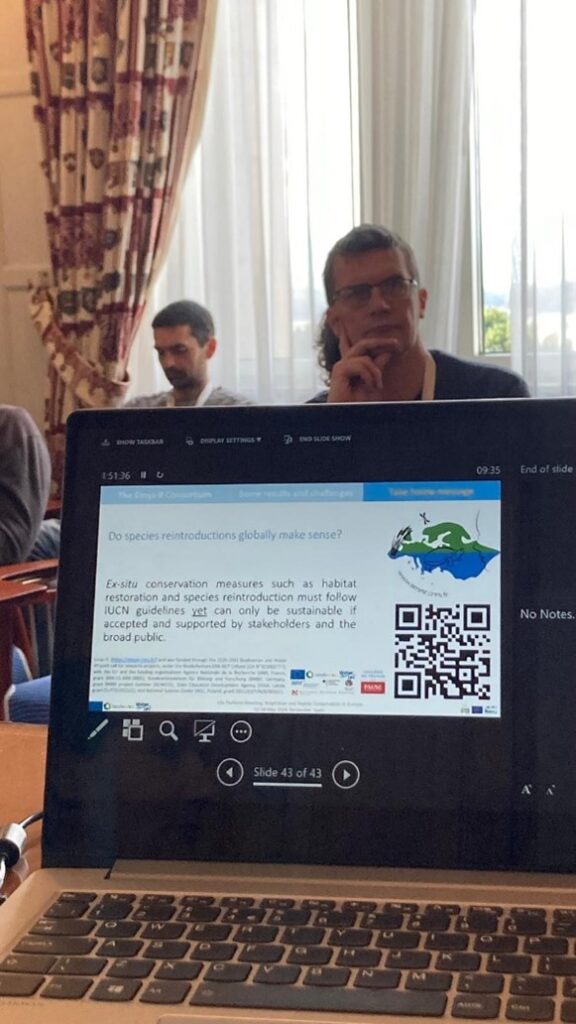
Key Conclusions and Insights: